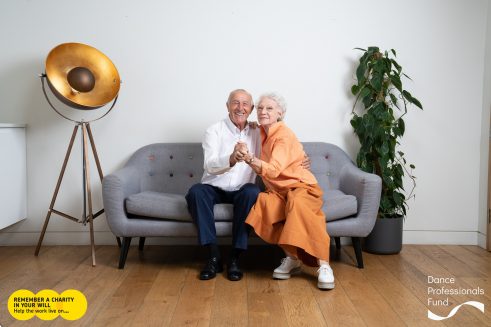We were saddened to hear this week of the passing of Len Goodman. His family have already set up a fundraising appeal for charities, and Len Goodman was in his own time instrumental in supporting charitable causes. During his time as an Ambassador for Remember A Charity, a campaign supporting charities to raise money through legacies, we benefited from his association. The publicity shot we are rerunning in our newsletter this month with our Patron Dame Monica Mason and Len in 2019 is testimony to that fact.
What a different world it was when Len Goodman moved from welder to dancer (by chance, following a foot injury needing rehab). When he opened his Goodman Dance Academy, the TV programme Come Dancing was something viewers considered very much for the ‘mums and dads’. In recent months, the BBC has been running early episodes of the series and I have been watching it. The two teams meet to compete for the grand prize (not a Glitter Ball in those days but a rather more sedate trophy). In the 1970s mainly amateur dancers competed against amateurs with few, according to the information provided, turning professional. By the 1980s more contestants did take part in professional competitions, but they were not really known outside the world of ballroom dance.
Back in the 1970s the judges and host were overwhelmingly white and male, save for the odd female dance teacher. Many of the dancing partnerships existed outside of dance too, always heterosexual – a voice over commentary confirms for instance ‘Julie is a secretary who is looking forward to marrying Paul’. We also had it confirmed for our interest that ‘Joyce made her own dress in crystal chiffon’.
By the 1980s, the voice over confirms that there are now female contestants ‘studying fashion design’ or ‘setting up their own clothing business’ although apart from the fact that Angela Rippon was now the compere, little else seems to be different. In recent years the BAFTA nominated Vikki Gill talks about the costume design each week, in the ‘Putting on the Glitz’ section of Strictly It Takes Two. Both Strictly compères are now women. How things have changed from the female perspective.
In the office, we usually follow the professional dancers with more interest than the celebrities they are tutoring. In reality there is a partnership of two celebrities, the dancer, and the famous face they are teaching to dance. The composition of those taking part is now considerably more diverse than in the last century. By including contestants from diverse backgrounds, who are also in the public eye, the BBC could be accused of simply massaging the viewing figures with well-known faces while at the same time ticking the diversity box. But it is a fact that the programme is the perfect forum to shine a spotlight on diversity though the contestants, professional ballroom dancers, and judges alike.
It is wonderful that the opportunity exists to do this. We are always mindful about what we can do to support the diverse range of dance professionals who come to us for support. This includes an ongoing review and development of our Equality, Diversity, and Inclusion (EDI) strategy to make sure we are taking the right steps to do so.
It’s a different world from the one Len Goodman started out in, made obvious by his fear of a backlash to same sex dancing on Strictly. But he also said, of his time judging same sex dance competitions, “They were of a very high standard, terrific dancing actually’. At heart, always simply the teacher. A final thought, in the 1992 film Strictly Ballroom, the message is that you should be allowed to dance to your own steps. One truth remains, dance is a wonderful way to both express yourself and to be yourself – no matter who you are or even how well you can dance. I trust Len Goodman would agree.






